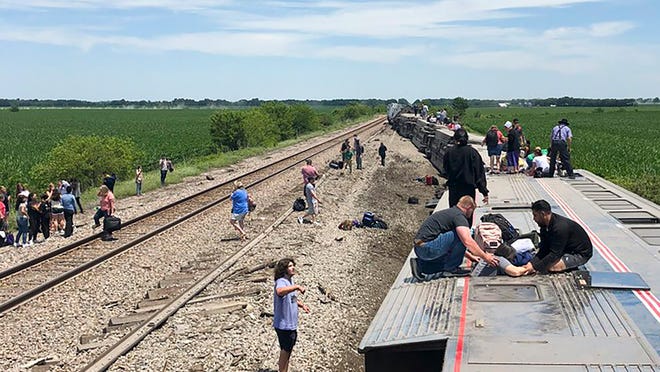DENVER – Since a fiery Ohio derailment on Feb. 3 brought new attention to the rail industry, trains have derailed in many other states, including Florida, West Virginia, Michigan, Oklahoma, Alabama and Nebraska.
Among the latest was a BNSF freight train that derailed Thursday afternoon along the banks of the Mississippi River in Wisconsin, sending at least two cars into the water.
Before that, it was one carrying beer in Montana. Over two dozen cars tipped over on April 2, but posed no risk to the public or the nearby Sheep Creek, officials said. That followed a March 30 ethanol train derailment in rural Minnesota that prompted the evacuation of hundreds of people.
Data shows these derailments are not unusual.
Every day, the nation’s railroads move millions of tons of raw materials and finished goods around the country on about 140,000 miles of rails, but their safety record is getting new attention amid the ongoing scrutiny of the East Palestine derailment disaster.
Federal data from 2021 and 2022 says an average of about three trains derail in the U.S. a day. While not all derailments are equally as dramatic or dangerous, railroads are required to report any derailment that causes more than $10,700 in damage.
Longer trains, fewer workers: Another derailment follows years of railroad cost cutting
VIDEO:Rockslide derails West Virginia train, 3 injured
Although that number isn’t as bad as it used to be, there’s now a growing push for tougher safety regulations, including a new bipartisan proposal in Congress aimed at improving rail safety. Railroad workers say large freight railroads have been skimping on maintenance, repairs and staffing in order to squeeze out higher profits.
“No American family should be forced to face the horror of fleeing their homes because hazardous materials have spilled or caught fire in their community,” said the bill’s sponsors, Ohio Sens. Sherrod Brown, a Democrat, and JD Vance, a Republican. “Americans are now rightfully concerned about the safety of railroads carrying hazardous materials as trains travel through their communities.”
How often do trains derail in the US?
According to federal records, trains derailed 1,164 times last year, and 1,095 times in 2021. That’s a significant improvement from past decades. In 1979, for instance, railroads reported 7,482 derailments, and reported 6,442 in 1980.
Today, the majority of those derailments happen in freight yards. Because the cars on yards are frequently being switched between tracks, there’s a greater chance of derailing, experts told USA TODAY.
NEWS:Second Norfolk Southern train derailment in Ohio shines congressional spotlight on rail industry
EXPLAINED:Just how dangerous is the Ohio derailment disaster? Why it’s confusing.
“About 60% of all rail accidents occur in yards where there are more complex operations and lower speeds that tend to cause minimal damage,” said Jessica Kahanek, a spokesperson for the Association of American Railroads, a trade group. “More than half of those are caused by human factors or human error.”
Railroads are required to report any derailment that causes more than $10,700 in damage.
How often do hazmat crashes happen?
While most train derailments and crashes are relatively harmless, hazardous materials have spilled or leaked from trains more than 5,000 times in the United States in the past decade, according to a USA TODAY analysis of federal incident reports. In comparison, there were 67 hazmat leaks from highway transportation for every rail last year, according to federal records.
DATA:How often do train wrecks spill hazardous chemicals into neighborhoods?
Still, in 2022 alone, rail operators reported 337 hazardous material leaks or spills, only 32 of which were classified as “serious.” Only six were reported to have caused an injury. Railroad derailments counted for 1 in 10 hazmat wrecks in the past decade – and 1 in 4 of those incidents last year, USA TODAY found.
AAR, the trade group, says that 99.9% of all hazmat shipments reach their destination without incident and that the hazmat accident rate has declined 55% since 2012.
What about passenger trains?
Passenger trains such as Amtrak also experience derailments. In June 2022, an Amtrak train crashed in central Missouri, killing four people after colliding with a dump truck. And in September 2021, Amtrak’s Empire Builder derailed in northern Montana, killing three people. The causes of both crashes remain under investigation.
Last year, railroad deaths totaled 978, the highest since 2007, according to the National Safety Council. Most of those deaths were not derailments or crashes, but instead people killed while trespassing on train tracks. Seven passengers were killed last year, compared to 11 railroad employees.
Railroad safety bill proposed
Introduced on March 1, the Bipartisan Railway Safety Act of 2023 aims to increase train safety while ensuring communities get the help they need to deal with hazardous materials spills when they happen. President Joe Biden has already endorsed the legislation.
Specifically, the bill:
- Dramatically increases fines for safety violations, raising them from a maximum of $225,000 to up to 1% of a railroad’s annual operating income, which for the largest carriers like Norfolk Southern could be more than $50 million.
- Mandates railroads pay for more hazmat response training in communities where trains roll through.
- Mandates “hotbox” detectors” every 10 miles to remotely sense if a passing train’s wheels are getting too hot, which federal experts say is what caused the East Palestine derailment.
- Requires two-person conductor-engineer crews on most freight train routes.
- Funds research into safer tank cars that are less likely to spill or leak.
“This legislation provides us with tools to hold companies accountable to prevent terrible tragedies like the Norfolk Southern derailment in East Palestine and to make those communities whole,” Biden said.
Contributing: Tami Abdollah, Jayme Fraser, USA TODAY; The Associated Press


